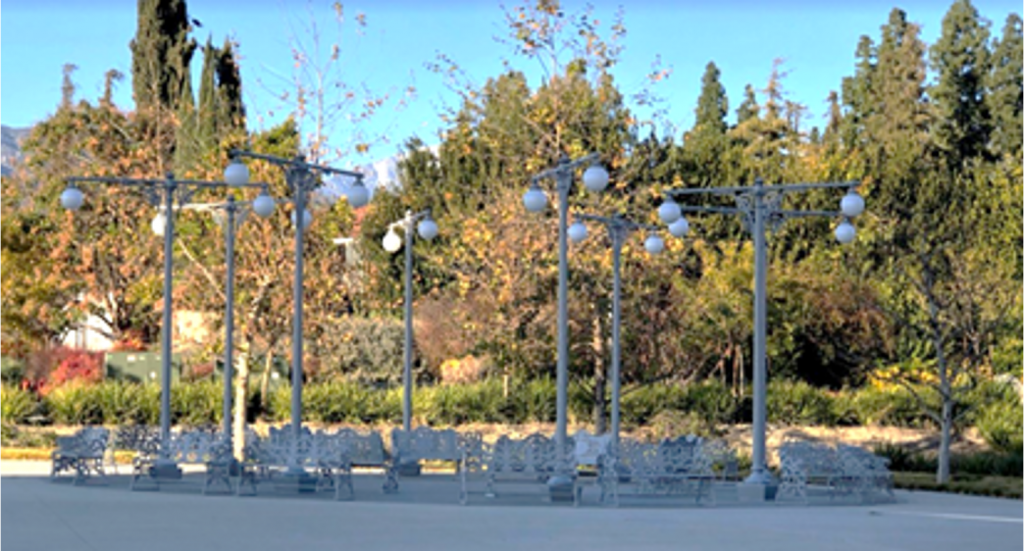Hannah Grunow SC ’22
Art Columnist/Photographer
Have you wondered where monuments and public art in the news or on our campus came from? Who created them, with what funds, and why? This column will address these questions, starting with a piece of public art on Claremont McKenna College’s campus, “Meet in the Middle.” This piece stands next to the Roberts Pavilion gym, creating an interesting contrast between this piece’s antique style and the gym’s ultramodern design.
“Meet in the Middle,” a circular arrangement of metal benches and streetlamps, might look somewhat familiar to you. The mélange of many antique lamps is reminiscent of the Los Angeles County Museum of Art’s (LACMA) display of 202 streetlamps (titled “Urban Lights”)—and indeed, they were created by the same artist.
Artist Chris Burden (1946 – 2015), of Boston, Massachusetts, attended Pomona College as an undergraduate, where he studied both physics and architecture; according to Britannica, he went on to receive an M.F.A. from UC Irvine. Burden primarily creates installation art and sculptures.While a student at Pomona College in 1967, Burden created another piece, “Untitled Sculpture,” which was a large-scale yellow-and-black piece made out of plywood. A new version of the piece was later recreated out of aluminum, which is on Pomona’s campus today, according to the Pomona College Museum of Art.
Burden’s pieces, interestingly, are characterized as masochistic by Britannica. One of his more famous pieces, for example, was called “Shoot,” in which the performance consisted of a friend shooting him in the arm. However, the piece at CMC is meant to evoke positivity. CMC’s website says that “Meet in the Middle” is “optimistic, welcoming, and provocative, and will provide a social setting where students and faculty can interact with the sculpture and each other.” “Meet in the Middle” was installed in 2015, seven years after Burden’s LACMA piece. The article also notes that the piece was donated by CMC graduate, George Roberts ’66. Roberts also donated a totem sculpture done by Ellsworth Kelly at the same time.
While “Meet in the Middle” only features eight lamps (194 less than “Urban Lights”), the piece captures the same antique charm as his LACMA piece. Following the analysis by curator Miwon Kwon in her book “One Place After Another,” CMC’s piece might be considered “art as a public space,” meaning a piece of art that people can interact with (given that it was meant to function as a gathering space). This style of art became popular in the United States during the 1980s, following criticisms that the method of creating “art in the public space,” like Calder’s “Flamingo,” was too inaccessible to the general public and did not add anything to urban spaces. Uses of materials like streetlights and benches were in fact building blocks of the “art as a public space” movement, in which art was meant to disappear into its surroundings as a functional space. This creates an intersection between art and its use value as opposed to simply aesthetic value.
Burden’s “Meet in the Middle” is especially interesting with regard to the concept of “art as a public space” given that it carries a rather unique interpretation of site specificity. That is to say, while the art piece blends into the site seamlessly through functionality, it poses a large contrast between its own antique style and the pop art of the Roberts Pavilion through the lens of aesthetics. During the current pandemic, however, we might wonder—what is the role of art serving a function for the public when the public is nowhere to be found?
Image Source: Hannah Grunow



